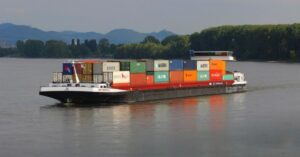You are present in a lot of segments, how is the business climate globally and in India?
Post-pandemic, there has been a huge capacity increase by the shipping lines, because shipping lines thought that the only way people will consume is when the goods are delivered at their doorstep and people will not travel and there was a huge demand for movement of goods from all over. So, there was a big gap between the demand and the supply, resulting in price increase. The shipping lines thought this is a good opportunity to increase the capacities. The capacities went up. Then subsequently the pandemic got over and people started traveling. So, the consumption cycle changed, in fact the consumption has reduced and several economies are facing a steady state. Especially the European economies are experiencing a lack of growth and the American economy is reeling under inflation. So, there is a huge increase in interest rates pushing up the costs, so, the consumption going down has affected the logistics sector. So, to answer your question in one line, in the current context, yes, we are seeing that there is a lull in demand, and it will take a year for things to shape up. Another thing we are waiting for is the Ukraine war. I think the Europeans sentiments are a bit depressed because of the war situation. When that gets over, then I think the demand cycle will pick up.
So, that is, the global scenario but are you positive and bullish about the Indian scenario?
India is moving from being a 3 trillion-Dollar economy to become a 5 trillion-Dollar economy. We have 1.4 billion population. We are going global, with the geopolitics that has happened at the G20 Summit. We see more and more procurement happening from India, which gives us an advantage in term of keeping the buoyancy of the logistics service and we will have that demand which will go up in time to come but in India, we have that sweet spot and having the benefit of being one of the few or the only large economy which is growing at the rate of between 6% to 7%. So, we have that advantage but we cannot ignore the fact that…talking about international logistics, we still have excess capacity. Although we are at an advantage that advantage is kind of overcome by the excess capacity but we are still better off than lot of other countries globally.
Going back to the global scenario and being an international player, now what makes more business sense now? I think you have already entered into Bangladesh or Africa which seem to be very positive markets. So, can you tell a little bit more about the operations there and what do you see in the years to come.
These are all growing economies — East Africa and Bangladesh, but in terms of growth opportunities, their base is very low. It is important to have your flag there but the business opportunities are not as big as India, because the growth is not as fast as in India, or the volumes available in terms of absolute numbers are not as bigas in India. It is just one more addition in terms of the opportunities or segments that we operate in.
You talked about the buoyancy or positivity of the Indian economy. Do you see the same kind of developments happening in terms of our regulatory framework or the approach of the government, because we have been claiming that we jumped 6 spots on the Logistics Efficiency Index. What has positively changed in our industry and what are the specific changes that you would like to see?
So, what has changed in our industry is basically the hard infrastructure. So, we have continuous addition of new roads, upgradation of the railways, Dedicated Freight Corridors which is on the verge of completion. We have new port terminals which have come up in the last 5 to 10 years and some of the new ones are coming up, like after Vallarpadam, that was one of the last ones, and new capacity has been added at Mundra, the Vizhinjam port is coming up. I think there is some development on the East Coast when it comes to Dhamra and Haldia, etc. So, this has greatly helped us to achieve efficiency in terms of movement of goods. When it comes to the software, as in terms of the processes and systems, I think we still have some opportunity for us to do that better because theirwhole concept of community system or seamless data flow has still not been achieved because we are still operating in silos. Government did come up with a Gatishakti Portal. But, it has its own teething issues and there will be a time by which things will happen. So, the seeds have been sowed. So, it will be sometime before we get a benefit of that.
Years ago, when we talked about the freight forwarding business and especially logistics services, we said a lot of innovation and automation had to come in to differentiate from the competition. So, how are things now. Are the operators still struggling or are they migrating, have they become aggressive, how is the scenario?
Adoption of technology has been a little slow in our international freight forwarding and logistics industry because I think without implementation of technology, people are still able to sell their services, and there are no disruptions which are comingbecause I think one of the barriers for disruption to come in are ..you need to have huge investments. Because you are currently carrying a capacity, and people have lesser choices, you still end up selling your services with or without technology. So, there is no real reason for large logistics service provider to up their technology quotient. Even if you are a large service provider like a shipping line or a port terminal or just take for example the Indian Customs, they need to be aligned with all other service providers and everybody has to have the same technological quotient for adoption of technology. So, individually when you implement technology, its impact is much lesser but if everybody adopts the same technology, the impact is higher. So, I guess that’s where these initiatives of community service, initiatives of Gatishakti platform will help improving the technology quotient across all the players and that will really benefit the shippers as well as help in bringing down the transaction cost.
Another challenging scenario what we see is the supply chain services integration like now shipping lines have got into almost every sphere of activity, CFS operations, partnering with container terminals, operating trains and they are into air freight. So, how bad it is for a logistics service provider or a freight forwarder?
Yeah, it is interesting to see how it will impact. In the Indian context, the market is growing and the impact is not much because even if the shipping lines are offering the end-to-end solutions, there is always new business which is available for freight forwarders. So, if they have lost something to the shipping lines, they have gained something somewhere else, and there is a limitation to the kind of business a shipping line can service. They can only service large shippers, maybe having 50 or 100 containers a month. That’s their threshold. Anything below that they just don’t have the infrastructure, know-how to handle smaller customers, and that’s where technology can be used where customers can go on to their portal and use this. But firstly, they don’t have those portals and self-service kind of platforms are not ready to begin with or available and even whatever little is available, there is no incentive for the shippers to do it because at the same or a lesser cost, some other service provider is giving them a service at their doorstep – veryindividualized service because this is still a very people-oriented industry and people are able to give services at a nominal cost…very personalized services. So, to answer your question very shortly…yes, in Indian context, it has not made much impact as of now.
In the true sense, where are we achieving the multimodal transportation and what still government has to do to really enable the multimodal transportation?
Multimodal transportation is actually happening, when you move the container by road and load onto ship it is multimodal transportation or you move it by rail, put it ontoa ship is multimodal transportation. I think what is most important in multimodal transportation is that whenever the mode of transport is being changed…rail to sea, sea to road, or road to rail…what is the cost and time involved. I think that’s where this IT system, sophistication in terms of handling equipment, good quality infrastructure, all this come into play. So, multimodal transportation is happening… at the same time, there is a huge opportunity for it to be improvised and improved upon. So, the penetration is there, we still have huge amount of shippers who sit in the hinterlands and they are able to seamlessly undertake the activity of import or export. Unless the multimodal transportation did not exist, they would not have been able to do business, and it is growing. So, it is just a matter of achieving a higher level of sophistication which helps to reduce cost and time, is something that we need to concentrate on when it comes to multimodal transportation. So, the modal switch should be smoother, cheaper and faster.
Coming back to Teamglobal, can you give me an insight into what are your plans for the short-term and long-term?
Environment is one area that we are very serious about and we have embarked on an ESG initiative. As you know that we run India’s first green container freight station, and now we are taking that particular agenda across our offices. So, all our new offices…or whenever we do the furnishings, they are all green interiors, and now we are also working on concept whether how we can help our customers reduce their carbon footprint through green transport solutions. But in terms of green infrastructure, I think that’s what we already have in place. How do you offer green transportation solution is something we are very actively discussing and seeing whether we can offer it to our customers, and the other aspect of ESG is the social and the governance out of it. So, be it gender diversity, offering better working conditions, equitable pay is something that we are continuously evaluating our policies and we are ensuring that we are ahead of the curve and ensuring that our stakeholders, be it internal or external are beneficiary of our ESG practices. In the long-term we are looking for growth in infrastructure, whether we can have more presence. We are also looking at increasing our presence on the air freight side. So, we are looking if we can do some acquisitions to increase our presence in air freight.











